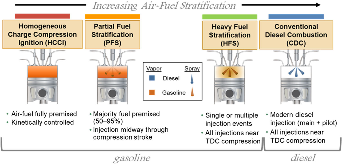Impacts of Air-Fuel Stratification in ACI Combustion on Particulate Matter and Gaseous Emissions
Since multi-mode engine combustion strategies are being investigated as a pathway to increased vehicle fuel efficiency, a better understanding of particulate matter formation during the advanced compression ignition (ACI) modes and the resulting PM properties are of growing importance for mitigating PM emissions and/or developing emissions control strategies. ACI combustion strategies have demonstrated extremely low engine-out soot while achieving high break thermal efficiencies. However, US-regulated emissions for particulate matter (PM) are on a mass basis, which can consist of ash, soot or elemental carbon (EC), and organic carbon (OC). The composition of PM mass from ACI combustion ranges from nearly 100% OC to a mix of EC and OC particulates as the extent of fuel stratification increases. How the mass, compositions, and morphology of PM changes as fuel stratifies within the combustion chamber and what this can tell us about PM formation are presented through multi-cylinder, metal engine experiments. Using ACI modes ranging from homogeneous to highly stratified approaches, this study aimed to advance the understanding of how air-fuel stratification and fuel properties impact PM emissions formation; advanced gaseous and solid emission characterizations are also given. This study is part of a collaborative multi-lab initiative at the US Department of Energy that aims to simultaneously transform both transportation fuels and vehicles in order to maximize performance and energy efficiency, minimize environmental impact, and accelerate widespread adoption of innovative combustion strategies by providing the underlying science for this initiative.
- Research Organization:
- Oak Ridge National Lab. (ORNL), Oak Ridge, TN (United States)
- Sponsoring Organization:
- USDOE Office of Energy Efficiency and Renewable Energy (EERE), Transportation Office. Vehicle Technologies Office; USDOE Office of Energy Efficiency and Renewable Energy (EERE), Vehicle Technologies Office (EE-3V)
- Grant/Contract Number:
- AC05-00OR22725
- OSTI ID:
- 1619414
- Alternate ID(s):
- OSTI ID: 1513379
- Journal Information:
- Emission Control Science & Technology, Journal Name: Emission Control Science & Technology Vol. 5 Journal Issue: 3; ISSN 2199-3629
- Publisher:
- Springer Science + Business MediaCopyright Statement
- Country of Publication:
- United States
- Language:
- English
Similar Records
ADVANCING TURBULENT SPRAY AND COMBUSTION MODELS FOR COMPRESSION IGNITION ENGINE SIMULATIONS
Detection of Polar Compounds Condensed on Particulate Matter Using Capillary Electrophoresis-Mass Spectrometry














